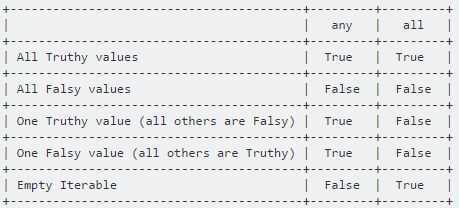Loops
http://www.geeksforgeeks.org/any-all-in-python
http://treyhunner.com/2016/04/how-to-loop-with-indexes-in-python
https://www.youtube.com/watch?v=Qgevy75co8c
The fastest way to loop in python is don't loop
- While loop
- For loop
- in-built functions like sum(range(100))
- numpy functions
- Mathematics with single operation i.e. no loop
Any and All are two built ins provided in python used for successive And/Or.
ANY�
Returns true if any of the items is True. It returns False if empty or all are false. Any can be thought of as a sequence of OR operations on the provided iterables.
It short circuit the execution i.e. stop the execution as soon as the result is known.
Syntax : any(list of iterables)
# Since all are false, false is returned
print (any([False, False, False, False]))
# Here the method will short-circuit at the
# second item (True) and will return True.
print (any([False, True, False, False]))
# Here the method will short-circuit at the
# first (True) and will return True.
print (any([True, False, False, False]))
Output -
False
True
True
ALL
Returns true if all of the items are True (or if the iterable is empty). All can be thought of as a sequence of AND operations on the provided iterables. It also short circuit the execution i.e. stop the execution as soon as the result is known.
Syntax : all(list of iterables)
# Here all the iterables are True so all
# will return True and the same will be printed
print (all([True, True, True, True]))
# Here the method will short-circuit at the
# first item (False) and will return False.
print (all([False, True, True, False]))
# This statement will return False, as no
# True is found in the iterables
print (all([False, False, False]))
Output -
True
False
False

Range
range() function starts at 0 aby default, and stops one number below the number passed to it. We can use list() function to efficiently generate a large list of numbers
for number in range(1, 1002):
print(number)
numbers = list(range(1,1000))
Range + Step Loop
N,M = map(int,raw_input().split())
for i in xrange(1, N, 2):
print ( str('.|.')*i ).center(M, '-')
print str('WELCOME').center(M, '-')
for i in xrange(N-2, -1, -2):
print ( str('.|.')*i ).center(M, '-')
Enumerate
http://book.pythontips.com/en/latest/enumerate.html
Enumerate is a built-in function of Python.
It allows us to loop over something and have an automatic counter.
for counter, value in enumerate(some_list):
print(counter, value)
enumerate also accepts an optional argument which makes it even more useful.
The optional argument allows us to tell enumerate from where to start the index.
my_list = ['apple', 'banana', 'grapes', 'pear']
for c, value in enumerate(my_list, 1):
print(c, value)
You can also create tuples containing the index and list item using a list.
my_list = ['apple', 'banana', 'grapes', 'pear']
counter_list = list(enumerate(my_list, 1))
print(counter_list)
Basic for in loop
colors = ["red", "green", "blue", "purple"]
for color in colors:
print(color)
Unlike traditional C-styleforloops, Python'sforloops don't have index variables. There's no index initializing, bounds checking, or index incrementing. Python's for loops do all the work of looping over our numbers list for us.
https://treyhunner.com/2019/06/loop-better-a-deeper-look-at-iteration-in-python
for and while loop can have else branch
# Python's `for` and `while` loops
# support an `else` clause that executes
# only if the loops terminates without
# hitting a `break` statement.
def contains(haystack, needle):
"""
Throw a ValueError if `needle` not
in `haystack`.
"""
for item in haystack:
if item == needle:
break
else:
# The `else` here is a
# "completion clause" that runs
# only if the loop ran to completion
# without hitting a `break` statement.
raise ValueError('Needle not found')
contains([23, 'needle', 0xbadc0ffee], 'needle')
None
contains([23, 42, 0xbadc0ffee], 'needle')
ValueError: "Needle not found"
# Personally, I'm not a fan of the `else`
# "completion clause" in loops because
# I find it confusing. I'd rather do
# something like this:
def better_contains(haystack, needle):
for item in haystack:
if item == needle:
return
raise ValueError('Needle not found')
# Note: Typically you'd write something
# like this to do a membership test,
# which is much more Pythonic:
if needle not in haystack:
raise ValueError('Needle not found')
While loops
A simple while loop
current_value = 1
while current_value <= 5:
print(current_value)
current_value += 1
Letting the user choose when to quit
msg = ''
while msg != 'quit':
msg = input('What's your message? ')
print(msg)
do while loop in python
i = 1
while True:
print(i)
i = i + 1
if(i > 5):
break
Using Zip to loop over multiple lists at the same time
colors = ["red", "green", "blue", "purple"]
ratios = [0.2, 0.3, 0.1, 0.4]
for color, ratio in zip(colors, ratios):
print("{}% {}".format(ratio * 100, color))